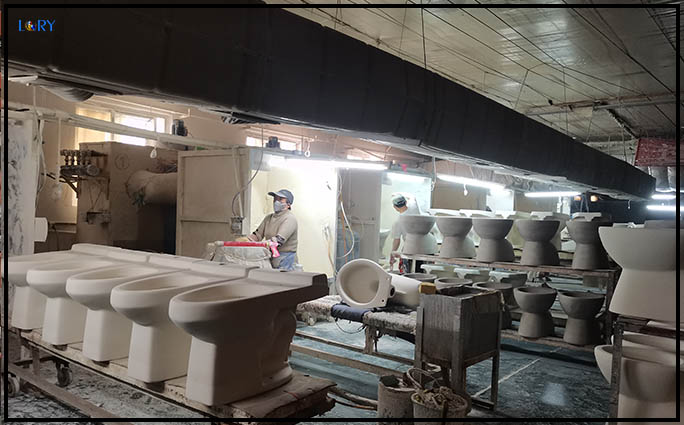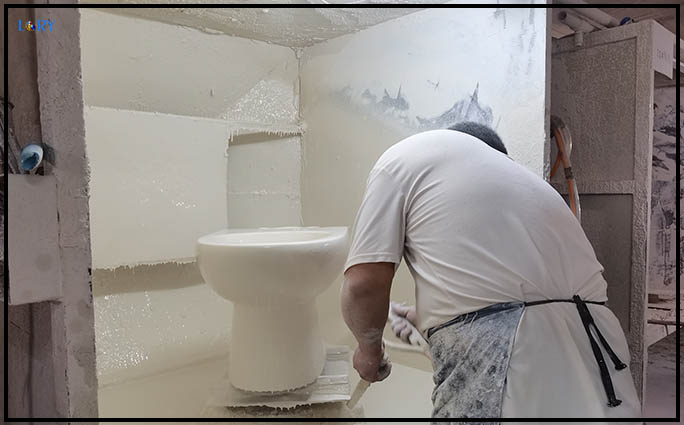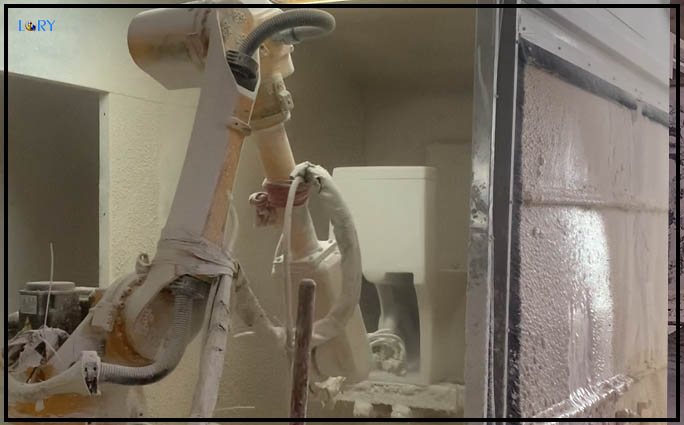The glaze spraying process plays a vital role in the production process of the entire ceramic sanitary ware. Today as a professinal toilet manufacturer, we will learn more about the method and function of the ceramic sanitary ware spraying glaze process. We elaborate on the following aspects:
1. The concept of glazing
2. What are the ingredients of the glaze and how to make the glaze
3. Preparation before glazing
4. Description of glazing methods (including manual glazing and robot glazing) and specific operation process, matters needing attention
5. What is the function of glazing

1.The Concept of Glazing:
Glazing is a process in which a thin layer of glass-like material, known as glaze, is applied to the surface of ceramic sanitary ware. The glaze is typically composed of various minerals, such as feldspar, quartz, clay, and metal oxides. It is applied to the ceramic ware to provide a decorative and protective finish. The glaze is applied in a liquid form, which solidifies during the firing process, creating a smooth, glossy surface.
2.Ingredients and Preparation of Glaze:
The ingredients of a glaze can vary depending on the desired characteristics and color. However, the basic components of a glaze include:
Silica: Provides hardness and durability to the glaze.
Feldspar: Lowers the melting point of the glaze and improves its stability.
Clay: Enhances the workability of the glaze and helps it adhere to the ceramic surface.
Metal Oxides: Used to achieve specific colors and effects in the glaze.
To make the glaze, the ingredients are mixed together with water to form a slurry. The mixture is then milled to ensure a homogeneous and smooth consistency. This milling process helps break down the particles and removes any impurities.
3.Preparation Before Glazing:
Before glazing, the ceramic sanitary ware must go through several preparation steps to ensure proper adhesion and a smooth glaze application. These steps may include:
Cleaning: The ceramic ware is thoroughly cleaned to remove any dirt, dust, or oils from the surface. This is important for ensuring good adhesion of the glaze.
Drying: The ceramic ware is dried completely to eliminate any moisture that could affect the glaze application and firing process.
Surface Smoothing: Depending on the desired finish, the ceramic surface may be smoothed or polished to remove any imperfections.
4.Glazing Methods and Operation Process:
There are two main glazing methods: manual glazing and robot glazing.
Manual Glazing: In manual glazing, skilled workers apply the glaze by hand using brushes, spray guns, or dipping techniques. The process involves carefully and evenly applying the glaze to the ceramic ware’s surface, ensuring complete coverage. Workers need to have a good understanding of glaze consistency, thickness, and application techniques to achieve the desired results.

Robot Glazing: Robot glazing involves the use of automated systems to apply the glaze. Robots are programmed to follow precise paths and apply the glaze in a controlled and consistent manner. This method is often used for large-scale production to improve efficiency and minimize human error.

Regardless of the glazing method, there are some common considerations and precautions:
Consistency: The glaze must have the right consistency to ensure even application. It should be fluid enough to flow smoothly but not too thin to cause dripping or running.
Thickness: The glaze thickness needs to be carefully controlled to achieve the desired appearance and prevent defects. Too thin of a glaze layer may result in a dull finish, while too thick of a layer can lead to unevenness or excessive drips.
Uniformity: The glaze should be applied uniformly across the entire surface of the ceramic ware. Care must be taken to avoid missed spots or overlapping, which can result in uneven color or texture.
5.Function of Glazing:
Glazing serves multiple functions in the production of ceramic sanitary ware:
Decorative Finish: Glazing provides an aesthetic appeal to ceramic ware, enhancing its appearance by adding color, texture, and gloss. It allows for a wide range of design options and customization.
Protection: The glaze forms a protective layer on the ceramic surface, making it less porous and more resistant to stains, scratches, and moisture absorption. It helps prolong the lifespan of the sanitary ware and ensures its durability.
Hygiene: Glazed surfaces are easier to clean and maintain, making them more sanitary for use in bathrooms and kitchens. The smooth, non-porous glaze prevents the accumulation of bacteria and dirt.
Chemical Resistance: The glaze provides resistance against various chemicals, ensuring that the ceramic sanitary ware can withstand cleaning agents and other substances commonly encountered in daily use.
To sum up, glazing plays a vital role in the production process of ceramic sanitary ware. It has decorative and functional benefits, enhancing a product’s visual appeal, durability and hygiene. Proper glass technology and attention to detail are essential for ceramic sanitary ware manufacturers to achieve high-quality, aesthetically pleasing sanitary ware that meets required standards and customer expectations.